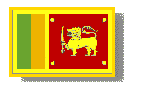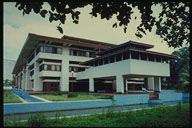 Sri
Lanka
Sri
Lanka
 Sri
Lanka
Sri
Lanka
 Directory Information
Directory Information
"The need of a National Library for Sri Lanka was keenly felt by the government, scholars and librarians after independence. The report on the local Government Service known as the Choksy report made a clear case of this need as far back as 1955. Among other subsequent commissions that emphasised the need for a National Library where the Commission on the Colombo Public Library (Kandiah Report 1958), the special commission report on Antiquities (Brohier report) and the Salaries and Cadres Commission (Wilmot Perera Report, 1959) as the report on School Libraries in Ceylon, by Harold V. Bonney, an UNESCO Library Expert in 1960."
"Since 1950, UNESCO organised a series of conferences in various parts of the world on the theme of national Planning of Library Services, with special reference to the establishment of National Libraries as apex organisations. In December 1967, the third meeting of Experts on National Planning of Libraries in Asia was held in Colombo. A National Library Development plan for Sri Lanka was formulated at this meeting."
The plan had twin objectives:
1. To assist library authorities in organising and developing their services as internal parts of the proposed national system.
2. To set up a central library institution to be named the National Library capable of taking their leadership in the country's library services and coordinating the services of libraries belonging to all other categories.
"The Sri Lanka National Library Services Board was established in 1970 under the Act No. 17 of the Parliament of Sri Lanka. The prime objective of this newly founded institution was the fulfillment of the long felt need for a National library. Consequently all other activities of the board were geared towards the achievement of this goal."
"The main problem encountered by the Board was the acquisition of a suitable site for the National Library. The present site was chosen and the building project was approved by the Cabinet of Ministers in 1974.
"1. Maintaining an outstanding and central collection of Sri Lanka's
literature.
2. Collection of Ola Leaf manuscripts and other important national
manuscripts.
3. Legal Deposit.
4. To maintain a foreign literature collection.
5. Publication of the National Bibliography.
6. Act as the National Bibliographical Information Centre.
7. Publication of Catalogues and other Bibliographical aids of the
other major libraries in Sri Lanka.
8. Coordinating Centre for Inter Library Lending.
9. Coordinating Centre for Inter Library Exchange.
10. Formulating Standards for Sri Lanka Libraries and information fields.
11. Assisting in library and information planning in Sri Lanka.
12. Research in library and information science.
13. Library services for the blind and the handicapped.
14. Library Education and Training activities.
15. Assist book publishing and the production of other library material.
16. Promotion of reading habits."
"While every library ought to be ideally sited in congenial surroundings very often public libraries are situated in very congested places, in the heart and hub of a city's bustle."
"So determined by inescapability of practical considerations. Not so in the case of a National Library, for there is too much value at issue to risk anything but near perfect conditions."
"A description of the location of our National Library will demonstrate how some of these conditions were met."
"It is situated on Independence Avenue in what is termed the Cultural Zone of Colombo. Within this zone can be found the national Archives, our immediate neighbour, the Sri Lanka Foundation institute University of Colombo, the National Museum, the Centre for Professional Associations, the Colombo Public Library, the Royal Asiatic Society, (Sri Lanka Branch), the Natural Resources Energy and Science Authority of Sri Lanka, the Ceylon Institute of Scientific and Industrial Research, the Sri Lanka Television Training Institute, Independence Hall, the Planaetarium, the Sri Lanka Institute of Development Administration and similar organisations and buildings of national and cultural significance."
"The area is rich with greenery and suffused with a lofty atmosphere and academic calm.
"In an effort to maintain these features, the government has decided not to permit the construction of any more high rise buildings in the vicinity."
"The 2.5 acre site has enviable advantages of being visible from many angles up to a considerable distance. This enables it to be established in the popular mind and view it as a national monument of great importance.
"The tree is one of the most expressive symbols of nature. It signifies protection, shade from the sun, as a source of nourishment and a place for calm reflections."
"In the Buddhist context, a tree stands for supreme enlightenment."
It is a happy augury of the Consultant Architect visualised the National Library building as a big tree, a shelter from the elements, with its dominant feature a big overhanging roof."
"Along with the association of growth here, of an organic structure driving roots into, and drawing sustenance from our native soil, is the idea of conservation and longevity. Here too, the architect saw the core of the building as a place of endless rejuvenation, the air conditioned book stock running through the entire building and forming its heart."
"The building is also intended to reflect its lofty purpose, to inspire a sense of awe and wonder, and have, over and above all, the appearances of a building that has, in the words of the architect, 'something of the solidarity and weight associated with traditional building. Like the temple of the tooth and other important shrines.'"
"It is hoped that the building would be, like other national monuments--the Museums, Independence Hall, the Colombo Town Hall, the New Parliament Building--symbols of our national cultural aspirations and values."
"To this end, materials that have emerged from the soil of the country have been used. Local hard wood, local clay tiles on the floor, brick and concrete from the enduring earth and rocks of our native quarries. The art work to follow likewise, by local artists, expressing the soul of our people. The mural o the wall depicting local vegetation is considered the largest mural in this part of the world."
"To enable the readers to have, in the words of the English poet, Andrew Marvel "a green thought in a green shade", there are reading areas which are naturally ventilated where readers when weary, may refresh their eyes by resting them on the lush greenery visible on all sides of the building."
"The library staff may similarly work in a cool and tranquil atmosphere so conducive to the creation, of a tranquil mind and gracious temperament."
"Like the core of the tree where the vital sap pulses, in this zone will be the ultimate treasure of the library, our national treasure--all the priceless books, periodicals, documents, newspapers, tapes and micro films covering both print and non print, audio visual that will remain in the custody of the National Library for the benefit of users for many, many years to come."
"Sri Lanka National Library Services Board has exchange programmes with a number of foreign national Libraries including those of India, Australia, Malaysia, Japan, USSR, USA and UK."
"Gifts and donations of private collections to the National Library, designated an approved charity since 1971, have also contributed immensely to the growth of the collection."
"The present stock of 150,000 volumes will form the nucleus of the future national collection which will eventually be expanded to accommodate around one million volumes."
"The present book stock of the National Library consists of the following collections:
Ground Floor
Newspaper collection,
Periodical collection,
Main Reference collection.
First Floor
Main Sri Lanka collection,
Foreign literature collection,
Legal Deposit collection,
Manuscripts and Rare book collection,
Map collection,
Audio Visual collection.
Second Floor
UNESCO collection,
Special collection,
Library & Information Science collection,
Folk lore collection.